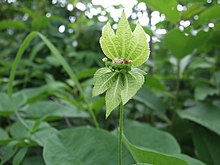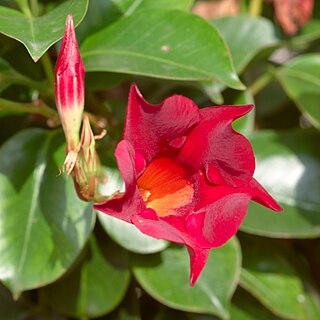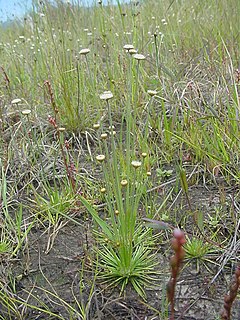| Dalechampia | |
|---|---|
 | |
| Dalechampia scandens , Ecuador | |
| Scientific classification | |
| Kingdom: | Plantae |
| Clade: | Tracheophytes |
| Clade: | Angiosperms |
| Clade: | Eudicots |
| Clade: | Rosids |
| Order: | Malpighiales |
| Family: | Euphorbiaceae |
| Subfamily: | Acalyphoideae |
| Tribe: | Plukenetieae |
| Subtribe: | Dalechampiinae |
| Genus: | Dalechampia L. 1753 |
| Synonyms [1] | |
Dalechampia is a genus of plant of the family Euphorbiaceae and of the monogeneric subtribe Dalechampiinae. It is widespread across lowland tropical areas (generally below 2,000 m ASL) primarily in the Americas with smaller numbers of species in Africa, Madagascar, and southern Asia. [1] [2] Additional new species are still being described and several are very rare and at risk of extinction. [3] [4] [5] [6]
Dalechampia has unisexual flowers that are secondarily united into bisexual blossoms (pseudanthia), which act as the pollination units. The pollination and floral evolution of this genus have been studied more intensively than perhaps any other member of the euphorbia family. In the neotropics (Americas), most species are pollinated by resin-collecting female bees, including euglossine bees and Hypanthidium of the Megachilidae, which use resin in nest construction. About a dozen neotropical species (including D. spathulata, shown below) are pollinated by fragrance-collecting male euglossine bees, which use these fragrances to attract females for mating. There are at least three independent pollination shifts from pollination by female resin-collecting bees to pollination by male fragrance-collecting bees. African and Asian species are also pollinated by resin-collecting megachilid bees, but Malagasy species are pollinated by pollen-feeding beetles and pollen-collecting bees.
Two species are of horticultural interest, D. spathulata and D. aristolochiifolia , have particularly showy blossoms with bright pink/purple bracts. Dalechampia aristolochiifolia , from Peru, has become very popular recently, but it is mistakenly advertised and distributed under the name D. dioscoreifolia .








- Species [1]
- Dalechampia adscendens – Bolivia, Mato Grosso do Sul
- Dalechampia affinis – N South America
- Dalechampia alata – Bahia, Rio de Janeiro
- Dalechampia albibracteosa – El Beni
- Dalechampia allemii – Bahia
- Dalechampia anomala – Paraguay, Paraná
- Dalechampia arciana – Bahia
- Dalechampia arenalensis – Costa Rica
- Dalechampia aristolochiifolia – Peru
- Dalechampia armbrusteri – Bahia, Espírito Santo
- Dalechampia attenuistylus – Venezuela, Suriname, Fr Guiana
- Dalechampia bangii – Bolivia, Paraguay, Rio Grande do Sul
- Dalechampia bernieri – Madagascar
- Dalechampia bidentata – Yunnan, SE Asia
- Dalechampia boliviana – Bolivia, Paraguay, Rio Grande do Sul
- Dalechampia brasiliensis – E Brazil
- Dalechampia brevicolumna – Suriname, Fr Guiana
- Dalechampia brevipedunculata – Amazonas in Brazil
- Dalechampia brevipes – Mato Grosso, Mato Grosso do Sul, São Paulo
- Dalechampia brownsbergensis – NE South America
- Dalechampia burchellii – Goiás
- Dalechampia burgeriana – Costa Rica
- Dalechampia burmanica – Myanmar
- Dalechampia canescens – SE Central America, NW South America
- Dalechampia capensis – E + S Africa
- Dalechampia caperonioides – Goiás, Brasília, Minas Gerais
- Dalechampia catati – Madagascar
- Dalechampia chevalieri – Cameroon, Central African Rep
- Dalechampia chlorocephala – Madagascar
- Dalechampia cissifolia – Mexico, Central America, NW + W South America
- Dalechampia clausseniana – Brazil
- Dalechampia clematidifolia – Madagascar
- Dalechampia convolvuloides – E Brazil
- Dalechampia coriacea – Bahia
- Dalechampia cujabensis – Mato Grosso
- Dalechampia decaryi – Madagascar
- Dalechampia denticulata – Cuba
- Dalechampia dioscoreifolia from Nicaragua to Bolivia
- Dalechampia elongata – N Thailand
- Dalechampia falcata – Cambodia, Thailand, Vietnam
- Dalechampia fernandesii – Ceará
- Dalechampia ficifolia – E Brazil
- Dalechampia fragrans – Suriname, French Guiana
- Dalechampia francisceana – Minas Gerais
- Dalechampia galpinii – southern Africa
- Dalechampia gentryi – Peru, NW Brazil
- Dalechampia glechomifolia – S Brazil, Misiones
- Dalechampia granadilla – Rio de Janeiro
- Dalechampia guaranitica – Paraguay
- Dalechampia hassleriana – Paraguay, Paraná
- Dalechampia hastata – Amazonas in Brazil
- Dalechampia herzogiana – Bolivia, Mato Grosso do Sul
- Dalechampia heterobractea – N Brazil, Venezuela, 3 Guianas
- Dalechampia hispida – Peru, Ecuador
- Dalechampia humilis – Brazil
- Dalechampia hutchisoniana – Peru
- Dalechampia ilheotica – Pernambuco, Bahia
- Dalechampia indica – S India, Sri Lanka
- Dalechampia ipomoeifolia – tropical Africa
- Dalechampia juruana – NW South America
- Dalechampia karsteniana – N Colombia
- Dalechampia katangensis – Katanga
- Dalechampia laevigata – S Mexico, Belize, Honduras
- Dalechampia leandrii – Rio de Janeiro
- Dalechampia leucophylla – Goiás
- Dalechampia liesneri – S Venezuela, NW Brazil
- Dalechampia linearis – Brazil, Paraguay
- Dalechampia luetzelburgii – Ceará, Pernambuco, Bahia
- Dalechampia magnistipulata – Veracruz, Oaxaca
- Dalechampia magnoliifolia – N + WC South America
- Dalechampia martiana – São Paulo
- Dalechampia megacarpa – S Venezuela, NW Brazil
- Dalechampia meridionalis – Uruguay, S Brazil
- Dalechampia micrantha – N + NW South America
- Dalechampia micromeria – S Brazil, Paraguay
- Dalechampia occidentalis – Mato Grosso
- Dalechampia olfersiana – Minas Gerais
- Dalechampia olympiana – Amazonas in Brazil
- Dalechampia osana – Osa Peninsula
- Dalechampia papillistigma – Bolívar
- Dalechampia parvibracteata – NE South America
- Dalechampia pavoniifolia – Somalia
- Dalechampia peckoltiana – Rio de Janeiro
- Dalechampia pentaphylla – Brazil
- Dalechampia pernambucensis – Ceará, Pernambuco
- Dalechampia perrieri – Madagascar
- Dalechampia psilogyne – Goiás
- Dalechampia purpurata – Bahia
- Dalechampia regnellii – Minas Gerais
- Dalechampia reitzkleinii – Santa Catarina
- Dalechampia riedeliana – Mato Grosso
- Dalechampia riparia – Santa Catarina
- Dalechampia rubrivenia - Paraguay
- Dalechampia scandens – Latin America, West Indies
- Dalechampia schenckiana – Pernambuco
- Dalechampia schippii – Belize
- Dalechampia schottii – Yucatán
- Dalechampia serrula – Canindeyú
- Dalechampia shankii – Central America, Colombia, Ecuador
- Dalechampia sinuata – Madagascar
- Dalechampia spathulata – Central America, S Mexico
- Dalechampia stenoloba – Karnataka
- Dalechampia stenosepala – S Brazil, Paraguay, NE Argentina
- Dalechampia stipulacea – South America
- Dalechampia subintegra – Bahia
- Dalechampia subternata – Madagascar
- Dalechampia sylvestris – Brazil, Paraguay, Bolivia
- Dalechampia tamifolia – Mauritius, Comoros, Madagascar, SW India
- Dalechampia tenuiramea – Brazil, S Venezuela, Bolivia
- Dalechampia tiliifolia – Central America, S Mexico, N + W South America, Trinidad
- Dalechampia trifoliata – E Africa
- Dalechampia triphylla – São Paulo, Rio de Janeiro
- Dalechampia uleana – Brazil, Peru, Bolivia
- Dalechampia ulmifolia – E. Paraguay, Rio Grande do Sul, Misiones
- Dalechampia variifolia – Minas Gerais
- Dalechampia velutina – Tamil Nadu
- Dalechampia violacea – Rio Grande do Sul
- Dalechampia viridissima – Bahia, Espírito Santo
- Dalechampia weberbaueri – Peru
- Dalechampia websteri – Nicaragua, Costa Rica, Panama
- Dalechampia weddelliana – Goiás, Mato Grosso, Mato Grosso do Sul, Paraguay









